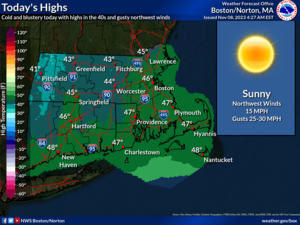
Snow, Sleet Predicted Overnight Wednesday
NORTH ADAMS, Mass. — The Northern Berkshires could be in for a wintry mix of snow and ice on Thursday morning.
The National Weather Service in Albany, N.Y., has a winter weather advisory in effect beginning at 9 p.m. on Wednesday through 1 p.m. on Thursday.
Plan on slippery road conditions, especially on untreated surfaces. The hazardous conditions could impact the Thursday morning commute.
Affected areas in Southern Vermont and the Northern Berkshires could see up to an inch of snow and ice accumulations of 2/10ths of an inch. The advisory also covers New York's southern Adirondacks and the Lake George-Saratoga region.
Precipitation will begin as a period of snow and sleet late this evening into the overnight hours, then transition to freezing rain by early Thursday morning. Freezing
rain will then change to plain rain by Thursday afternoon.
The temperatures dropped precipitously since Tuesday morning, when it was in the low 60s in North Adams. Wind chills brought the temperature down into the 20s on Wednesday morning.
But this is the Berkshires, so expect snow, rain and chills over the weekend with the possibility of the return of warmer weather next week. A low front moving up from the southeast is expected to bring higher than normal temperatures for much of the region.
Long-range forecasts show a rise into the 50s by the end of next week.
Tags: cold weather,



